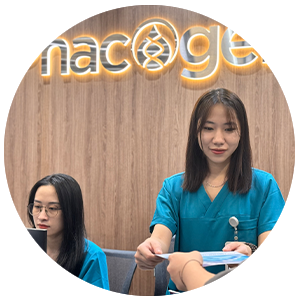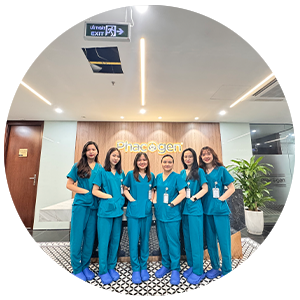Biotechnology has provided solutions to many serious human diseases. Around the world, the fate of more than 300 million people has changed thanks to drugs from biotechnology.
Today, patients can access more than 150 drugs and vaccines from biotechnology and that number is still increasing every day. Biological products are being used for many different purposes in medicine, from diagnosis to treatment. Biological products used to treat diseases are called biological drugs. Many biological drugs have been commonly used in treatment such as insulin, human growth hormone, erythropoietin, granulocyte colony-stimulating factor (G-CSF), interferon-alpha (INF-alpha) and monoclonal antibodies. such as rituximab and trastuzumab. When the copyright protection period expires, the original biological drugs (produced by the first research and development companies) will be tried by other manufacturers to research, produce, and circulate on the market. market, forming a group of drugs called biosimilars.
.
BIOSIMILARS
A biosimilar is a biological product that is similar in quality, safety and clinical effectiveness to a licensed reference biological drug product. Unlike generic pharmaceutical drugs, it is difficult to standardize biosimilar drugs, as they are complex products based on complex manufacturing processes. The characteristics of a biosimilar are almost impossible to define completely; it is similar but not identical to the reference drug. The production process of Biosimilars is quite complex, carried out in living cells with many production purification steps. Furthermore, just a small change in the overall manufacturing process can transform the structure and function of the drug protein.
.
There is a lot of controversy surrounding the definition and licensing of biosimilar drugs. At the heart of these debates is the difference between biosimilar drugs and simple copies of pharmaceutical drugs. While generic pharmaceutical drugs are identical copies, based on a clear definition of “similarity,” the same cannot be defined for biosimilar drugs because of their nature and the complexity of the manufacturing process. export. Analysis and preclinical trials are not sufficient to demonstrate the similarity or equivalence of two biological products.
.
Even companies, when starting a new drug production line, have difficulty recreating the same process. As a result, scientists believe that appropriate preclinical and clinical trials are needed to demonstrate that a biosimilar has the same clinical properties as the older drug. The legal basis for biosimilar drug approval in Europe is guided by the European Medicines Evaluation Agency (EMEA).
.
For the US, to be licensed as a biosimilar, a product must be nearly identical to the "comparison product" (a biological drug previously licensed by the FDA). Although there may be differences in the inactive ingredients, there should be no statistically significant clinical differences in safety, purity and potency.
.
Besides:
- Biosimilar drugs must have the same mechanism of action as the comparison product;
- The indications for a biosimilar drug have been previously approved for the comparable product;
- Route of administration, dose and pharmacodynamics must be similar to the comparison product.
.
The global market for biosimilars is growing rapidly as patents on key generic biologics expire. Biologics are among the most expensive treatments, which has led to high demand for lower-cost alternatives. In emerging markets, biosimilars have provided a more affordable solution that is more suitable for economies where expensive treatments are not feasible. finance for the people. However, there are still some concerns about the safety and effectiveness of these drugs for patients.
.
Leading biopharmaceutical companies have been investing to research and develop many important biosimilars. Up to now, there have been 9 biosimilar drugs, sold under 23 separate licensed brands in the United States, this number for the European market is 17 drugs with more than 50 brands. This market will continue to grow as the patent protection of many other important generic biological drugs expires in the coming years.
.
DEVELOPMENT AND PRODUCTION PROCESS OF BIOLOGICAL DRUGS
Biological drugs are proteins in nature, produced through a complex process, derived from recombinant DNA technology and created from living cells. This makes it difficult for biosimilar manufacturers to simulate and replicate the biological manufacturing processes and environmental conditions used in the development of the original products. Therefore, it is difficult for biosimilars to be completely identical to the original reference products.
.
As a first step in the manufacturing process, the DNA sequence that codes for the protein in the biologic is identified, isolated, ligated into a vector, and inserted into the genome of an appropriate host cell. A master cell bank with identical cells that produce the desired protein is established through cell screening and selection. That bank will be used for different scale cultures to determine the appropriate conditions to optimize protein production. During the post-fermentation processes, unwanted proteins and impurities are removed from the culture. The harvested protein is analyzed for structure and biological effectiveness through a number of physicochemical and biological analysis methods. Finally, the purified proteins will be prepared with excipients (such as antioxidants, osmotic agents or buffers...) and packaged and stored in appropriate conditions.
.
Because the manufacturing process is complex, modifying any step in biosimilar manufacturing (e.g., use of vector system, host cell system or culture medium, manufacturing method, refining and other excipients) can all alter the effectiveness and safety of a product. Therefore, manufacturers need to evaluate the impact of such changes using appropriate analytical and testing methods, as well as clinical studies to ensure that such changes do not adversely affect the product. product quality, purity, potency, safety and effectiveness. That is also something that regulatory agencies need to address when evaluating and approving biosimilar drugs.
.
DEVELOPMENT OPPORTUNITIES
The purpose of developing biosimilars is to reduce costs compared to generic drugs and capture their market share. As the patent period of more generic biologic drugs expires, the market for biosimilars will grow. Competitive markets will therefore play an important role in supporting the development of biosimilars. Biosimilars are expected to be 20% - 40% cheaper than generic products. These speculations stem from the fact that biosimilars of epoetin and filgrastim cost 30% - 40% less than the original drug.
.
The demand for biologic drugs is increasing in many areas of health care, the US Intercontinental Health Statistics Agency forecasts that the global biologic drug market will reach 250 billion USD by 2020, of which monoclonal antibody drugs account for the majority of the market share. Of this number, biosimilar drugs are expected to account for 4 - 10%, worth about 10 - 25 billion USD. However, this rate may increase when 12 products sharing 40% of the current biological drug market share will expire in 2020. There are currently more than 1,000 research and development processes being carried out. Conducted research to produce similar biological drugs of more than 100 original biological drugs on the market.
.
Although requiring a significant investment of time and money, developing biosimilars is more cost-effective than developing new drugs. As a result, the growth rate of biosimilars is expected to continue to increase. The biosimilar industry will bring many benefits to both science and healthcare.
.
Summary and editing: Ngọc Anh - Phacogen Institute of Technology;
(Master of Experimental Biology. University of Natural Sciences - Hanoi National University)
Referral:
Electronic information portal of Ho Chi Minh City Drug Testing Institute - Ministry of Health
https://www.ncbi.nlm.nih.gov/pmc/articles/PMC3737980/
https://gabionline.net/biosimilars/general/WHO-definitions-of-biosimilars
https://www.fda.gov/drugs/therapeutic-biologics-applications-bla/biosimilars
Source of article:
https://www.idqc-hcm.gov.vn/tin-tuc/tin-chuyen-nganh/109-khai-niem-ve-biosimilar.html





